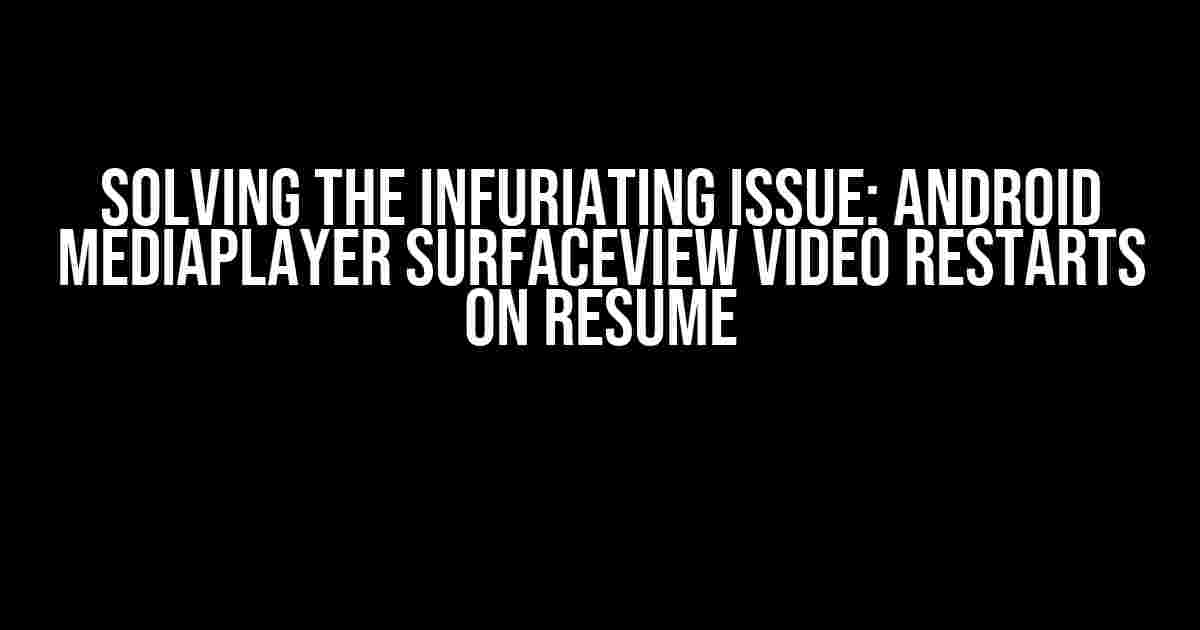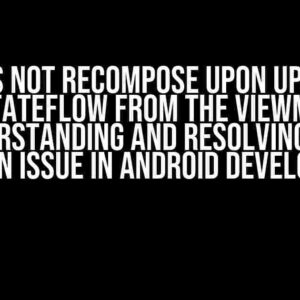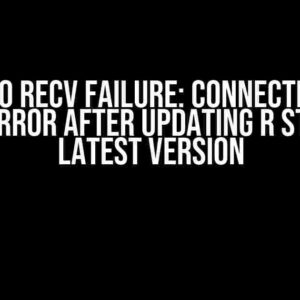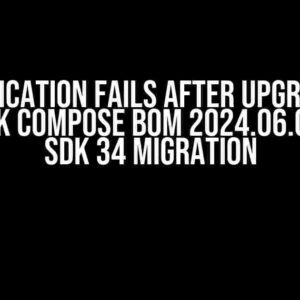Are you tired of dealing with the frustrating problem of your Android video app restarting every time the user resumes the activity? Do you find yourself scratching your head, wondering why your meticulously crafted video playback experience is being ruined by this annoying bug? Fear not, dear developer, for we’re about to dive into the depths of this issue and emerge victorious with a comprehensive solution!
The Problem: Android MediaPlayer SurfaceView Video Restarts on Resume
When your Android app uses a SurfaceView to display video content, you might encounter an unexpected behavior: the video restarts from the beginning whenever the user leaves the activity and resumes it later. This can be infuriating for users who expect a seamless video playback experience. But don’t worry, we’re about to explore the reasons behind this issue and provide a step-by-step guide to fix it.
Why Does This Happen?
There are several reasons why your video might restart on resume:
- SurfaceView recreation**: When the activity is paused and resumed, the
SurfaceViewis recreated, causing the video to restart. - MediaPlayer lifecycle**: The
MediaPlayerlifecycle is tightly coupled with the activity lifecycle, which can lead to video restarts when the activity is resumed. - Lack of proper video state management**: Failing to properly manage the video state (e.g., playback position, playback state) can cause the video to restart from the beginning.
The Solution: Saving and Restoring Video State
To solve this issue, we’ll implement a comprehensive solution that involves saving and restoring the video state, handling the SurfaceView recreation, and managing the MediaPlayer lifecycle.
Step 1: Save Video State on Pause
In your activity’s onPause() method, save the current video state:
@Override
protected void onPause() {
super.onPause();
if (mediaPlayer != null) {
mediaPlayer.pause();
int currentPosition = mediaPlayer.getCurrentPosition();
boolean isPlaying = mediaPlayer.isPlaying();
// Save the video state to SharedPreferences or a database
sharedPreferences.edit()
.putInt("current_position", currentPosition)
.putBoolean("is_playing", isPlaying)
.apply();
}
}
Step 2: Restore Video State on Resume
In your activity’s onResume() method, restore the saved video state:
@Override
protected void onResume() {
super.onResume();
if (mediaPlayer != null) {
int currentPosition = sharedPreferences.getInt("current_position", 0);
boolean isPlaying = sharedPreferences.getBoolean("is_playing", false);
mediaPlayer.seekTo(currentPosition);
if (isPlaying) {
mediaPlayer.start();
}
}
}
Step 3: Handle SurfaceView Recreation
In your activity’s surfaceCreated() method, set the SurfaceHolder callback:
@Override
public void surfaceCreated(SurfaceHolder holder) {
if (mediaPlayer != null) {
mediaPlayer.setDisplay(holder);
}
}
Step 4: Manage MediaPlayer Lifecycle
In your activity’s onDestroy() method, release the MediaPlayer resources:
@Override
protected void onDestroy() {
super.onDestroy();
if (mediaPlayer != null) {
mediaPlayer.release();
mediaPlayer = null;
}
}
Additional Tips and Tricks
To further enhance your video playback experience, consider the following:
| Tips and Tricks | Description |
|---|---|
| Use a Video Playback Buffer | Create a buffer to store the video playback position and state, allowing for a smoother resume experience. |
| Handle Configuration Changes | Save and restore the video state when the device’s configuration changes (e.g., screen orientation, language). |
| Implement Video Playback Controls | Provide users with playback controls (e.g., play, pause, seek) to enhance their video experience. |
Conclusion
By following these steps and implementing the provided solutions, you’ll be able to create a seamless video playback experience in your Android app. Remember to save and restore the video state, handle the SurfaceView recreation, and manage the MediaPlayer lifecycle. With these tips and tricks, you’ll be well on your way to creating an exceptional video app that delights your users.
Don’t let the frustrating issue of video restarting on resume hold you back any longer. Take control of your Android app’s video playback experience and provide your users with a memorable and engaging experience. Happy coding!
Remember to test your app thoroughly to ensure that the video playback experience is smooth and seamless. If you encounter any issues or have further questions, feel free to ask in the comments below!
Frequently Asked Questions
Got stuck with Android MediaPlayer SurfaceView video restarting on resume? Don’t worry, we’ve got you covered! Here are some frequently asked questions and answers to help you troubleshoot the issue:
Why does my Android MediaPlayer SurfaceView video restart from the beginning when I resume the app?
This might be due to the way you’re handling the MediaPlayer instance in your app. When your app is paused or resumed, the MediaPlayer instance might be getting recreated, causing the video to restart from the beginning. Try preserving the MediaPlayer instance by using a foreground service or by storing the instance in a retained fragment.
How can I maintain the video playback position when the app is resumed?
You can use the `seekTo()` method to resume playback from the last known position. Store the current playback position in a SharedPreferences or a file when the app is paused, and then retrieve it when the app is resumed. Use this position to seek to the correct point in the video.
Is it possible to pause the video playback when the app is paused, and resume it from the same position when the app is resumed?
Yes, it is possible! You can use the `pause()` method to pause the video playback when the app is paused, and then use the `start()` method to resume playback from the same position when the app is resumed. Make sure to store the playback position before pausing the video, and then seek to that position when resuming playback.
What if I’m using a SurfaceView to render the video, and the SurfaceView is being recreated when the app is resumed?
In that case, you might need to store the SurfaceHolder instance and reuse it when the app is resumed. This will allow the MediaPlayer to maintain its connection to the SurfaceView, and the video playback will resume from the correct position.
How can I debug issues related to video playback and SurfaceView recreation?
Use the Android Studio debugger to track the state of your MediaPlayer and SurfaceView instances. Set breakpoints in the `onResume()` and `onPause()` methods to inspect the instance variables. You can also use Logcat to log important events, such as video playback position and SurfaceView creation/recreation.




